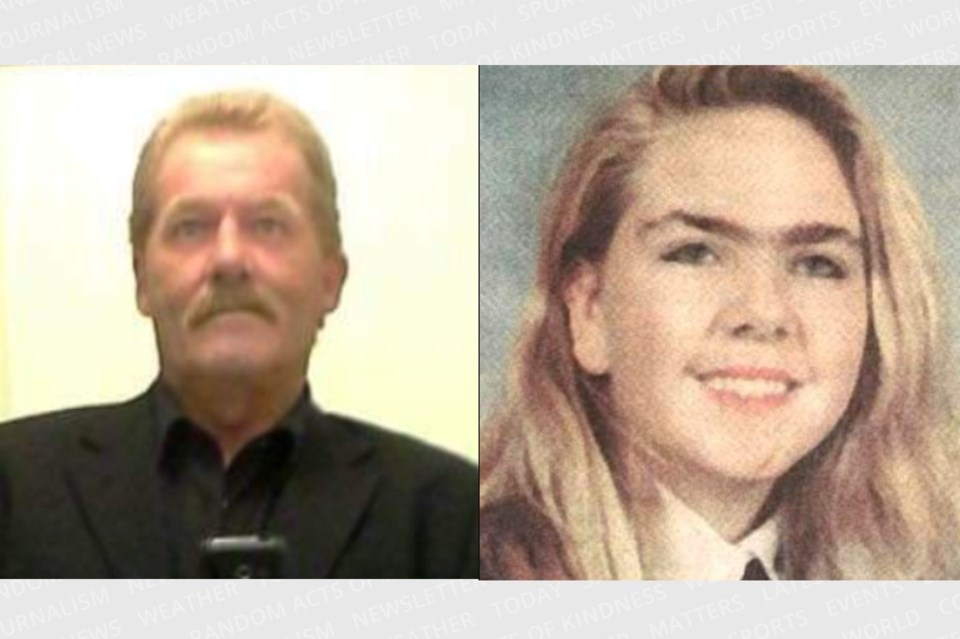Editor’s note: The following story contains graphic descriptions heard in court that may not be suitable for some readers.
A police bloodstain expert and the doctor who conducted the autopsy following Katherine Janeiro's stabbing death in Barrie 30 years ago both took the stand Tuesday on Day 11 of the ongoing murder trial.
Janeiro, 20, was found stabbed to death in her Dunlop Street West home on Oct. 10, 1994, near Anne Street.
Robert MacQueen, who is now 61 and is also known as Bruce Ellis, is on trial for second-degree murder in her death. None of the allegations against him have been proven in court.
Ontario Provincial Police Sgt. Mark Lancaster, an experienced bloodstain pattern analyst, took the stand to begin the day at the Barrie courthouse.
The jury was shown a slide presentation on the general study of bloodstain patterning to familiarize them with the terms and physics used by experts.
Lancaster said the report on his findings in this case was submitted for peer review to ensure his observations were “technically correct.”
Relying solely on photos taken by detectives in 1994, Lancaster discussed some of the limitations with basing his conclusions, mainly due to two-dimensional imagery along with low resolution images, as well as the inability to accurately assess distances between objects between more than one related photograph of the scene being investigated.
Lancaster walked the jury through his final report, which was shown to the court, describing blood staining throughout Janeiro’s apartment.
The expert was asked by assistant Crown attorney Mike Flosman if there was evidence in the photographs to suggest a body was dragged from the bathroom to the bedroom.
Lancaster replied he was “not seeing that” in his observations. He also said there was “nothing indicative of a cleanup” in regard to the state of the blood evidence in the bathroom.
Lancaster noted there was evidence of blood spatter on the wall in the living room above the couch, with ”stains in varying directionalities.” He also testified that many of the apparent blood stains in the apartment were due to an “external force applied, other than gravity.”
Flosman described possible scenarios which could have occurred during the Janeiro homicide, such as the stabbing of the victim, dropping the body on the bed and blood spatters due to arm-swinging motions.
Lancaster said “that could be possible,” from the evidence he has seen.
Flosman described another scenario where a “person was killed or grievously injured in the tub and then moved to the bedroom.”
He then asked, “do you see anything in the evidence that you saw that is inconsistent with that?”
“No,” Lancaster replied after a short pause.
During subsequent questioning by defence lawyer Mary Cremer, she highlighted the expert's inability to access the crime scene as it was 30 years ago. All he had to rely on were the police photographs taken at the time, and whether some of the red and brownish staining was actually blood at all.

She asked Lancaster if it was fair to say he made “assumptions” about the crime scene and the blood which was found on the walls, floor and door jamb, suggesting it's possible the blood stains “could have been deposited at entirely different times from each other,” as blood stains “can persist for a long period of time.”
“That is correct,” he answered.
Cremer asked: “It’s possible (small blood spatter on the wall above the couch) was produced by coughing or sneezing, isn’t that right?"
“That would be possible, yes … with the caveat that blood is in their nose or mouth,” Lancaster answered.
When the defence finished questioning of the blood-spatter expert, Flosman countered by asking Lancaster if someone was sitting on the couch, a sneeze or a cough would not result in blood hitting the wall above and behind them. Lancaster agreed.
The other witness of the day was Dr. David Chiasson, a forensic pathologist who performed the autopsy on Janeiro on Oct. 12, 1994.
At the time, Chiasson was Ontario’s chief forensic pathologist. He confirmed to the court the cause of Janeiro’s death was due to multiple stab and cut wounds.
Chiasson reviewed the extent of Janeiro’s injuries with the court, describing multiple, deep cuts to her neck area, with the use of graphic photos taken during her autopsy.
“When you see wounds like this, they are commonly caused by a knife,” he said.
MacQueen sat in his chair at a table behind his defence team, showing no emotion while listening intently to the description of the trauma to Janeiro's body.
Flosman asked how these cuts could have been made by the killer.
“They could have been done from in front or behind her,” said Chiasson, who admitted he was not able to determine which one.
The court session ended for the day with Chiasson scheduled to return to continue his testimony this morning.
The trial is expected to last seven weeks.
Court has heard the last time Janeiro had contact with anyone was around 4 a.m. on Oct. 10, 1994. Her body was discovered by a friend around 7 p.m. that night. Her two-year-old daughter had been visiting family members at the time of the homicide.
Last week, MacQueen's ex-wife testified that Janeiro had told her she was pregnant, and the father was believed to be MacQueen or possibly another man.
During opening statements, the Crown said Janeiro had a "therapeutic abortion" on Sept. 16, 1994, less than a month before she was killed.
According to news reports published by the former Barrie Examiner, had been at a pair of downtown bars most of Sunday night and early Monday morning prior to her body being found.














